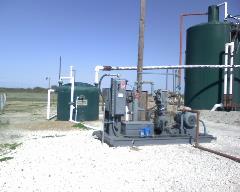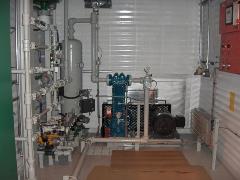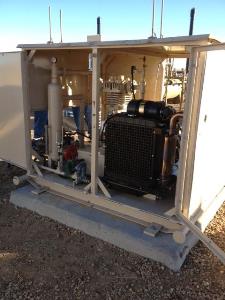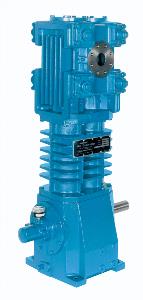New vapor-recovery regulations challenge oil and gas producers to optimize operations and Blackmer® NG, HD and HDS Series Oil-Free Reciprocating Gas Compressors can assist
Introduction
There has always been an economic rationale for oil and natural gas producers to capture or recover as much product as possible in the oilfield. Namely that any vapors that were vented to the atmosphere or flared off during the production process were no longer saleable, or not worth the time and labor needed to reclaim them. Now, there is an even more important reason for these producers to optimize their operation’s vapor-recovery capabilities.
In August 2011, the U.S. Environmental Protection Agency (EPA) introduced New Source Performance Standard 40 CFR, Part 60, Subpart OOOO, which quickly became know as the “Quad O” regulation. In October 2012, Quad O became law and began affecting oil and gas storage facilities, natural gas processing plants and gas wells across the country.
Basically, Quad O establishes emission standards and compliance schedules for the control of volatile organic compounds (VOC) and sulfur dioxide (SO2) emissions from storage tanks at tank batteries that are used to temporarily hold liquids produced during the production of oil and natural gas. More specifically, Quad O includes a requirement that VOC emissions be limited to less than six tons per year (tpy)—a daily equivalent of 33 pounds—from storage tanks that contain crude oil, condensate, produced water and other unrefined petroleum liquids.
Per the edicts of the Quad O regulation, the storage-tank universe was divided into distinct two groups:
• Group 1: Any storage vessel constructed, reconstructed or modified after Aug. 23, 2011, but before April 12, 2013
• Group 2: Any storage vessel constructed, reconstructed or modified after April 12, 2013, or within 60 days after startup, whichever is later
On April 15, 2014, all Group 2 storage tanks must be fully compliant with Quad O, while all Group 1 tanks have until April 15, 2015, to attain Quad O compliance.
This has led to a rush by oil and natural gas producers to upgrade their vapor-recovery abilities so that their tank batteries will emit less than the allowable six tpy of VOCs and SO2. This white paper will demonstrate how a specific type of compressor technology—oil-free reciprocating gas compression—can be used to maximize the performance of vapor-recovery units at storage facilities, all with the ultimate goal of satisfying the emission limits of the EPA’s Quad O regulation.
The Challenge
Crude oil storage tanks have always had issues with gas vapors escaping, even though most tanks do have various types of door hatches, gaskets and low-pressure pop-off vent valves that have been designed to control and limit the amount of product vapors that are escaping the tanks. With no real strong environmental regulations restricting this venting, many tanks were, and are, in poor shape, with faulty hatches and safety valves that leak badly. In some cases, operators do not even close the hatches, or the tanks have faulty gaskets that allow vapors to leak uncontrollably. In many instances, releases would occur simply due to the build up of vapor pressure in the tanks, which would cause the tank’s relief valves to open and release the excess vapor pressure.
The Quad O mandate requires that 95% of vapor releases now be contained, or either flared or reclaimed. For the reclaiming process, several types of compressors have been popular for this operation. Rotary vane and rotary screw compressors, as well as reciprocating piston compressors, are all used. Depending on the overall operating conditions (required flow rate and discharge pressure) a particular compressor technology would be selected.
However, oil-free reciprocating gas compressors are ideal for applications where discharge pressures are around 50 psig (3.4 barg), and in some extreme cases can be as high as more than 500 psig (34.4 barg). Typical discharge pressures from crude oil storage tanks are usually less than 200 psig (13.8barg).
The challenge for the compression equipment is that traditional lubricated piston compressors and some rotary designs do not have leak-tight sealing and the ability to handle the small amounts of condensed liquids (condensate) that can form in the compressor. This condensate collects in the crankcases on some reciprocating compressors and contaminates the lubricating oils, causing extremely frequent nuisance oil changes and, in many cases, significant power-frame damage to bearings and shafts. In many cases, frequent complete compressor replacement is considered “acceptable” when the damage is considerable.
Oil-free reciprocating gas compressor technology with a distance-piece design provides operators a unique feature that allows the condensate to be collected and controlled at the compressor’s distance piece, keeping it out of the critical power-frame area where damage can occur. The added bonus of the oil-free design is that it has two sets of rod seals that seal the gas at the distance piece, reducing the amount of gas vapors that can escape to the environment through the crankcase, which is typical in most styles of reciprocating machines.
The Solution
Recognizing the untapped potential for an improved vapor-recovery technology in the oilfield, Blackmer®, Grand Rapids, MI, USA, a member of Dover Corporation’s PSG®, Oakbrook Terrace, IL, USA, offers a full range of compressor products that cover a broad range of markets, including oilfield vapor-recovery applications.
Blackmer’s NG , HD and HDS Series Oil-Free Reciprocating Gas Compressors were born to handle hazardous, toxic or flammable gases. Their oil-free design provides truly unique features that were at one time considered unneeded and unimportant in the natural gas market. These features have a very strong environmental appeal while offering the best vapor-recovery mechanics and sealing technology.
• Oil-free designs do not add any additional contamination to the gas being handled or recovered
• Maximum control of gas leakage from the compressor is achieved because of the compressor’s full distance piece compartment and piston-rod seals. The two sets of rod seals create a compartment between the process gas and the lubricated crankcase, which provides leakage control and minimizes any leakage to the crankcase or the atmosphere.
• Ductile-iron construction of all pressure parts results in greater resistance to harmful thermal and mechanical shock
• High-efficiency PEEK valves are specially designed from a self-lubricating material that provides superior sealing characteristics, high efficiency and durability
• A heavy-duty, precision-ground crankshaft features roller bearings and integral counterweights to ensure smooth, quiet operation
All of these design advances mean that all Blackmer compressors are an environmentally friendly and safe method to move and recover gas vapors. In today’s highly regulated tank vapor-recovery applications these important features help deliver peace of mind to the oilfield operator and producer.
The distance-piece design feature of the NG, HD and HDS Series compressors is critical because condensate can form inside the compressor due to the wide mix of hydrocarbons that can often be found in the gas stream. Formation of condensate inside the compressor is never good. When the gas is compressed, heavier hydrocarbons and small amounts of water vapor can form. Compressors that do not have a distance piece will let the condensate leak directly into the crankcase. This condensate can damage the quality of the lubricating oil and will lead to significant bearing damage or a complete failure of the power frame.
Blackmer oil-free reciprocating gas compressors help control condensate that may form inside the compressor. Blackmer’s oil-free compressor designs do provide a means to control small amounts of condensate by collecting the condensate in an area of the compressor called the distance-piece compartment. Easy operator access to this compartment allows the user to empty the distance-piece compartment regularly. The distance piece can also be vented to a safe disposal area when available. This design gives the distance piece the ability to provide an effective means of controlling condensate.
While single-compartment distance-piece designs will generally satisfy most design requirements, Blackmer also offers triple-packed (two-compartment distance-piece models) for applications where leakage control is extremely critical. These proven designs have been used in industrial and chemical plant applications for many years. Blackmer’s single-stage NG, HD and HDS models, which are recommended for use on low to moderate compression-ratio applications, are available in seven sizes with piston displacements up to 125 cubic feet per minute (212 m3/hr) at working pressures up to 1,000 psia (69 bara). The three two-stage HD and HDS models, which are available for higher compression-ratio requirements, offer piston displacement up to 53.7 cubic feet per minute (91.2 m3/hr) at a working pressure up to 615 psia (42.4 bara).
Conclusion
In January, the North Dakota Petroleum Council’s Flaring Task Force reported to the North Dakota Industrial Commission that it felt that the state’s oil and gas industry can increase natural gas capture to 85% of total volume produced within two years, to 90% by 2020 and up to 95% within the next decade. To reach those levels, however, will require full buy-in from a number of entities, most notably the oil and gas companies operating in the state.
Process-system designers and environmental-compliance managers at those oil and gas companies—and at others around the country—will improve their chances of 95% capture of natural gas by continuing to incorporate improved vapor-control technology that minimizes the amount of vapors and VOCs that are released to the atmosphere at tank-battery locations.
Oil-free reciprocating gas compressor designs like those offered by Blackmer provide a safe and effective method to control potentially dangerous vapor emissions. In addition to their environmentally friendly benefits, oil-free reciprocating gas compressors provide economic advantages to operators due to their ability to efficiently recover gas from a variety of storage tanks, which leads to a higher amount of saleable end-product while simultaneously protecting the atmosphere. When used in many tank-battery applications, the VRU equipment will have a very lucrative payback period.
About the Author:
Glenn Webb is a Senior Product Specialist for Blackmer® and can be reached at glenn.webb@psgdover.com or (616) 475-9354. For more information on Blackmer’s full line of pumps and compressors, go to blackmer.com. Blackmer is a member of PSG®, which is comprised of several leading brands, including Abaque®, All-Flo, Almatec®, Blackmer®, Ebsray®, Finder, Griswold™, Maag, Mouvex®, Neptune™, Quattroflow™ and Wilden®. You can find more information on PSG at psgdover.com.

The amount of vapors from liquids that are produced during oil and gas production that will be allowed to escape from storage-tank batteries will be greatly curtailed thanks to the Environmental Protection Agency’s new “Quad O” regulation. Blackmer® stands ready to help oil and gas producers and handlers meet the edicts of Quad O with a complete family of innovative, reliable Oil-Free Reciprocating Gas Compressors.

The new Quad O mandate requires that 95% of storage-tank vapor releases be contained, or either flared or reclaimed. Blackmer® Oil-Free Reciprocating Gas Compressors help ensure that that threshold is met.

A vapor-recovery unit featuring a Blackmer® NG, HD or HDS Series Oil-Free Reciprocating Gas Compressor is one of the most reliable ways to control the amount of vapors that are lost to the atmosphere at a crude oil tank battery.

Blackmer® HD Series Oil-Free Reciprocating Gas Compressor